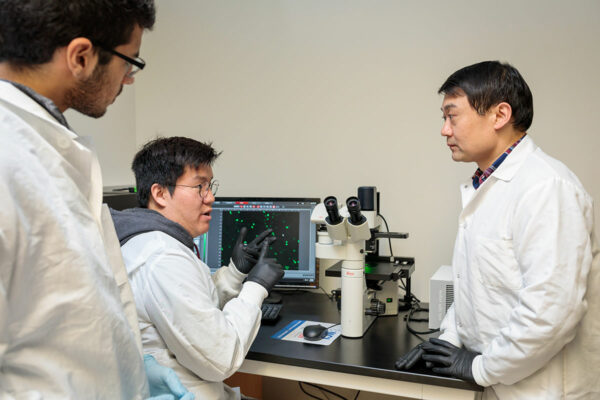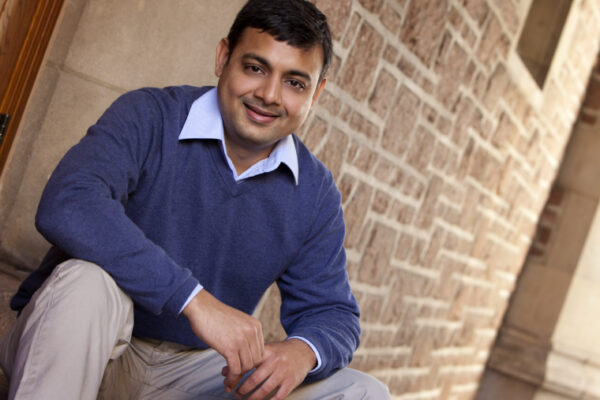Jumping genes are short sections of DNA that have been incorporated randomly into the human genome over the long course of evolution. Also called transposable elements, these pieces of DNA have been implicated in the development of cancer.
But new research from Washington University School of Medicine in St. Louis suggests that transposable elements in various cancers potentially may be used to direct novel immunotherapies to tumors that don’t typically respond to immune-based treatments.
The study is available online in the journal Nature Genetics.
Immunotherapy is often most effective in tumors with numerous mutations, such as skin and lung cancers. Mutations in DNA cause cancer cells to produce unusual proteins that distinguish tumor cells from normal cells and serve as targets — called tumor antigens — for immunotherapies, such as antibodies, vaccines and genetically engineered CAR-T cell therapies. But many tumor types don’t contain large numbers of mutations and are therefore harder for the immune system to identify as a threat.
“Immunotherapy is an extremely promising approach for cancer treatment, but current therapies don’t work in many tumor types in which the mutation burden is low,” said senior author Ting Wang, the Sanford C. and Karen P. Loewentheil Distinguished Professor of Medicine. “We are excited about this research, because it opens up an entirely new way to identify tumor antigens in types of cancer that have previously been invisible to immunotherapy.”
Jumping genes — believed to have possibly originated from viruses — usually are found in parts of the genome that are inactive in adult tissues. But past work by Wang and his colleagues showed that these transposable elements sometimes can function as hidden on switches, forcing a gene to be turned on all the time, even though it should not be. As these stealthy on switches drive cancer growth, they also can churn out unusual pieces of proteins that are unique to the tumor and not present in normal cells.
In an analysis of 33 tumor types from the National Cancer Institute’s The Cancer Genome Atlas Program, the researchers identified 1,068 transposable element-derived transcripts — or sections of RNA made by the cancer cells — with the potential to produce tumor antigens that could serve as targets for new immunotherapies.
Wang and his colleagues determined that these possible tumor antigens were present on the surfaces of cancer cells, making them ideal for targeting with immunotherapies. Importantly, they found that almost 98% of the more than 10,000 tumors analyzed had at least one potential antigen target arising from a transposable element. Most tumors had from two to 75 possible antigens.
In another important finding, the researchers showed that many of the candidate proteins that could serve as antigens were present in multiple tumors and, in some cases, across tumor types. Wang and his colleagues speculated that this raises the possibility of a universal antigen-based therapy that could treat multiple tumors with a single cocktail targeting several of the most common tumor antigens that arise from jumping genes. For example, the data suggest that a vaccine with a combination of 20 of the most common protein targets could cover about 75% of patients across 27 cancer types.
“With this analysis, we can envision the design of a cancer vaccine that targets the top five or top 10 most common tumor proteins that are caused by transposable elements,” said Wang, also a research member of Siteman Cancer Center at Barnes-Jewish Hospital and Washington University School of Medicine. “This type of vaccine is still just an idea, but we are excited about the potential, because these common targets could cover a large fraction of tumors. Much more work is necessary, but we are hopeful that this analysis can serve as a starting point for the development of effective immunotherapies across many more cancer types.”
Shah NM, Jang HJ, Liang Y, Maeng JH, Tzeng S, Wu A, Basri NL, Qu X, Fan C, Li A, Katz B, Li D, Xing X, Evans BS, Wang T. Pan-cancer analysis identifies tumor-specific antigens derived from transposable elements. Nature Genetics. March 27, 2023
This work was supported by the National Institutes of Health (NIH), grant numbers 5R01HG007175, U24ES026699 U01HG009391 and T32 GM007067; an American Cancer Society Research Scholar Grant, number RSG- 14-049-01-DMC; a Howard Hughes Medical Institute Medical Research Fellowship; and the National Science Foundation, grant number DBI-1827534.
About Washington University School of Medicine
WashU Medicine is a global leader in academic medicine, including biomedical research, patient care and educational programs with 2,800 faculty. Its National Institutes of Health (NIH) research funding portfolio is the third largest among U.S. medical schools, has grown 52% in the last six years, and, together with institutional investment, WashU Medicine commits well over $1 billion annually to basic and clinical research innovation and training. Its faculty practice is consistently within the top five in the country, with more than 1,800 faculty physicians practicing at 65 locations and who are also the medical staffs of Barnes-Jewish and St. Louis Children’s hospitals of BJC HealthCare. WashU Medicine has a storied history in MD/PhD training, recently dedicated $100 million to scholarships and curriculum renewal for its medical students, and is home to top-notch training programs in every medical subspecialty as well as physical therapy, occupational therapy, and audiology and communications sciences.



